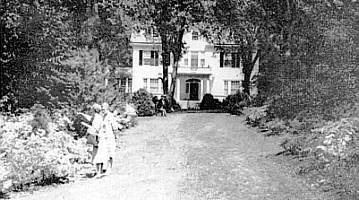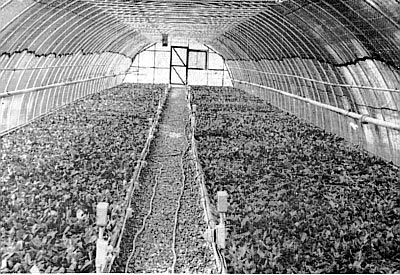Three Annual Meetings
J. Harold Clarke
It was my pleasure, this spring, to attend three Annual Meetings of rhododendron enthusiasts. Most of the papers presented will be printed in the Bulletin but some of the sidelights may be of interest to those unable to attend. The primary rhododendron interest of most of our members is, of course, in the plants, but the further one gets into this fascinating hobby the more attention he gives to people, the other people involved in the same hobby, from whom one may learn important things, and with whom one may discuss rhododendrons interminably.
Southern Chapter Meeting
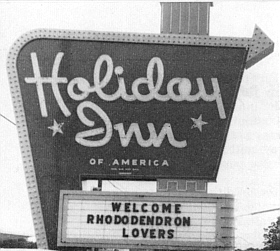
|
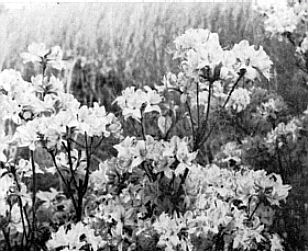
|
|
Fig. 42 Headquarters Inn in Fayetteville,
Arkansas welcomes members of the Southern Chapter to their Annual meeting. |
Fig. 45 Close up of
R. roseum
on Raspberry
Knob, Arkansas. |
My first stop was at the first Annual Meeting of the Southern Chapter in Fayetteville, Arkansas. This ambitious new Chapter, less than a year old, has spread clear across the South and was able to attract 34 people, from half a dozen states to its first annual get-together. The first day, April 29, was spent visiting some nearby stands of R. roseum. The next day began with a trip to Bentonville, to see the garden of Neil Compton, M.D. where there were a number of unusual native trees and shrubs used in the landscape. Dr. Compton took the group into his recreation room for a showing of slides of azaleas native to the region.
At the meeting in the afternoon the group heard a paper (printed in this issue of the Bulletin) by Geoffrey Wakefield, of Jefferson Island, La. Mr. Wakefield is an experienced gardener, recently come to the U.S., with experience in several well known English gardens and is the author of "Rhododendrons for Every Garden." Cultural Methods
Arthur Coyle, of Houston, Texas, discussed culture and disease control under southern conditions. He suggested October planting for all Rhododendrons in the South, but especially for landscape sizes, over 12"-18". Smaller plants may be set in early spring if there is an adequate root ball. For most southern areas, and especially where the soil is a little heavy or poorly drained, Mr. Coyle recommends planting on top of the ground, or even on top of a layer of gravel, with a mixture of organic matter, such as peat and inorganic material as sand or perlite, used to fill around and to the top of the root ball. Such a mixture provides very sharp drainage and so care must be taken during dry weather to see that the medium is moist to the bottom of the root zone.
The prime purpose of the special attention to drainage is to make conditions unfavorable for the development of root rot fungi, especially
Phytoph
thora and
Rhizoctonia
. Judicious use of certain fungicides as drenches seems to be helpful. Details are spelled out in the "Newsletter" of the Southern Chapter of May 23, 1967.
Mr. Coyle mentions as probably more resistant to root rot than some other varieties the following: 'Gomer Waterer', 'Roseum Superbum', 'English Roseum', 'Mrs. T. H. Lowinsky', 'Loder's White', 'America', 'Album Elegans', 'Vulcan', 'White Pearl', and 'Jean Marie de Montague'.
Over watering is conducive to root rot development. It is normal for soft new growth to droop during the heat of mid day. If the new leaves on well established plants are above the level position early in the morning the plants do not need watering in areas where moisture must be carefully controlled because of root rots.
Some A. R. S. Chapters are formed by experienced rhododendron growers who want to meet, exchange experiences and talk over new varieties. The Southern Chapter is made up of a few experienced growers who have fought unfavorable conditions and "learned the hard way" and a much larger number looking for cultural information because they have tried unsuccessfully to grow rhododendrons, or have never tried them because they were told "Rhododendrons would not grow in the South." Their goal is to develop and provide information so that the types of rhododendrons other than azaleas may be grown where ever azaleas are now grown. I have never seen a group more willing to sit into the wee small hours talking enthusiastically about how to grow rhododendrons under their conditions.
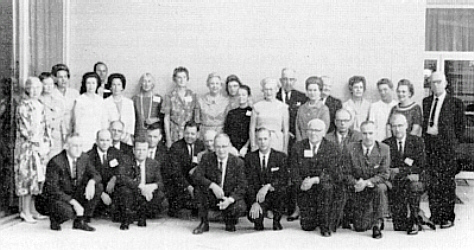
|
|
|
Fig. 43: Members of Southern Chapter attending first
Annual Meeting of the Chapter at Fayetteville, Arkansas, with their President, Arthur Coyle, front center. |
|
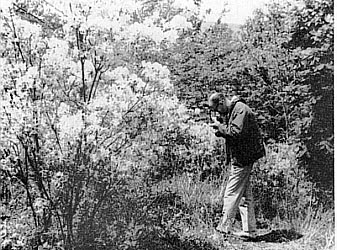
|
|
Fig.44: Mr. Howard Pike of Little Rock,
Arkansas, photographs one of the fine plants of R. roseum on Raspberry, Knob, north-central Arkansas |
After the meeting the group was invited to drive about 100 miles east, and a little south, to see a stand of R. roseum which was recently set aside by then Governor Faubus as an Azalea State Park. I had the pleasure of riding with Mr. and Mrs. Howard Pike, of Little Rock, Ark., to Raspberry Knob where several acres of beautiful pink azaleas in full bloom were seen. Their fragrance was noticed before any plants could be seen. One wonders how such groups of azaleas get started in a particular area and how long it has taken to cover the considerable acreage now well studded with mature plants.
U. S. D. A. Visits
My itinerary carried me on to the U. S. D. A. research station at Beltsville for a conference with Dr. August Kehr, who gave one of the principal addresses at the Annual Meeting in Tacoma ("Breeding for a Purpose" in the July, 1966 Bulletin). At the National Arboretum the rhododendron and azalea collections were visited in company with the Director, Dr. Henry Skinner. Good progress is being made in a study of the Glenn Dale Azaleas to facilitate easier and more positive identification.
In discussions with Dr. Fred Meyer in charge of the National Herbarium, housed at the Arboretum, it developed that he is interested in building up the collection of rhododendron material. There is a need for a first class collection of herbarium specimens of this Genus, in this country, as an aid to identification of important plants whose identity is questioned, without having to send plant material to the Herbarium at the Royal Botanic Garden in Edinburgh.
Middle Atlantic Chapter Meeting
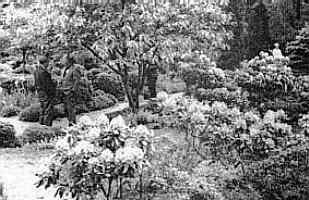
|
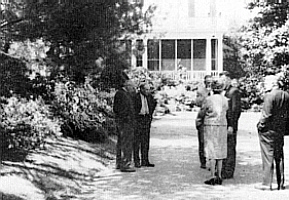
|
||
| Fig.46: A portion of the Wheeldon garden. |
Fig. 48 Members of the Middle Atlantic
Chapter gathering in the driveway at the home of A.R.S. Director, Thomas Wheeldon |
||
|
|||
The Annual Meetings of the Middle Atlantic Chapter have been reported in the Bulletin form time to time but this was the first one I had had an opportunity to attend. A group of about three dozen gathered, on May 5th, at the home of Thomas Wheeldon, M.D. in Richmond, Va. Dr. Wheeldon was, for many years, President of the Chapter and is now an elected Director of the A.R.S. The group was entertained at lunch by the Wheeldons after looking over the very complete collection of azalea varieties and the many rhododendrons surrounding their home.
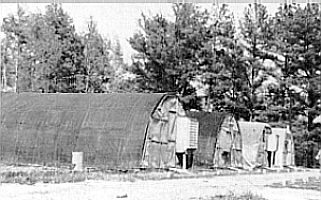
|
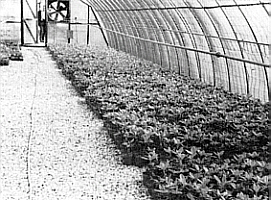
|
||
|
Fig.49: A battery of plastic houses at
Dr. Wheeldon's Gladgay Nursery. |
Fig.50: Rhododendron liners potted
up and waiting to go out into the lath house. |
||
|
|||
In the afternoon the group went by bus to a new nursery area, to which the Wheeldons have just moved their nursery operations from land adjacent to their home. The new place was in production with four large propagating houses which had been moved from the former site. Young plants go into a lath house, into raised beds, with walkways cut quite deep to provide excellent drainage.
The Annual Meeting itself was held following a banquet and was presided over by the President, Robert E. Lee of Charlottesville, Va. Victor Ries, Professor Emeritus from Ohio State University, gave the principal address, an illustrated talk on companion plants to use with Rhododendrons and Azaleas.
A.R.S. Annual Meeting
The Wheeldons kindly offered to drive me to Asheville so the next day was spent in the beautiful rolling country of southern Virginia and northern North Carolina. Rhododendron fans had gathered from all directions. A final tabulation indicated 188 registered, from 18 Chapters, and from 22 states, from B. C. and Quebec, and from England. I believe this is the widest representation we have ever had at an Annual Meeting.
The formal program opened Sunday afternoon with a panel discussion by a group of fanciers drawn from as far east as the British Isles, west from Oregon, north from northern Pennsylvania and south from central Georgia. Reports of these discussions are presented elsewhere in the Bulletin as is the address by Dr. Donald Wyman given during the evening.

|
|
Fig. 37 Members of the panel at the A.R.S. Annual
Meeting at Ashville, N.C. Left to right: Dr. Donald Wyman, Arnold Arboretum, Ernest Yelton, program chairman for the meeting; Thomas Wheeldon, Dr. Fred Galle, Mr. Frank Knight, Dr. David Leach, Carl Phetteplace. |
The second day was devoted to garden tours each of which had something of special interest. Because of a slight drizzle, which made the westerners feel right at home, the tours were shortened and I did not get to all the gardens. The garden of Mr. and Mrs. Doan Ogden, laid out in many terraces, was a private botanic garden, containing some 1250 different species of plants, used in the landscape or collected in fitting environmental groups.
At the home of Mr. and Mrs. John Dennis we saw where large rhododendrons had been cut to the ground so they might bush out and, for a while at least, be lower and more compact. Other homes visited included those of Mr. and Mrs. E. D. Mitchell, Mr. and Mrs. Charles D. Owen, Mr. and Mrs. Phillip Stull, Mr. and Mrs. Charles D. Owen, Jr., and Mr. and Mrs. George Cecil. Mrs. Cecil was in charge of the garden visitation program and proved to be a very knowledgeable garden guide in the gardens mentioned and at the Biltmore Estate the following day.
During the afternoon, Monday, we were given an opportunity to inspect the Rhododendron Show, of which we hope to have a report for the next issue. At night there were two addresses, by scientists working with rhododendrons, which we hope to publish after they have "gone through channels" to get the necessary approval.
Biltmore Visited
Tuesday morning was spent at the Biltmore estate, seeing the mansion and the gardens, but especially the fine collection of native azalea species and forms for which the gardens are noted. Quite a number of rhododendrons have been planted also. After a picnic lunch at Biltmore the group returned to the Grove Park Inn to hear David Leach. A report on his informative talk appears elsewhere in this issue. The Annual Meeting itself and the feature address of Mr. Frank Knight of Wisley Gardens are also reported.
What we cannot report in any detail are the many new friendships made, the pleasant discussions, the many kind services performed by the local committee, and the wealth of Rhododendron information shared in private conversation. All go to make up a meeting such ass this, and it was a good one.
Van Landingham Garden
After the meeting a post-convention tour had been announced to the garden of Mr. Ralph Van Landingham of Charlotte who has approximately a thousand plants of some 200 varieties. Due to the fact that most of the bloom had passed the tour was called off "officially" but the welcome sign was still out and several went to Charlotte to enjoy Mr. Van Landingham's hospitality.
I had the pleasure of riding to Charlotte, in the company of Dr. and Mrs. John Wister, through the courtesy of Dr. Herbert Hechenbleikner of the University of North Carolina at Charlotte. After visiting the Van Landingham garden Dr. Hechenbleikner took us to the Campus where he is planning to establish a sizeable collection of rhododendron species and varieties. The site, a ravine with a brook and ample water and shade, seems about as nearly ideal as one could wish. Within a few years this should be one of the most important rhododendron collections in the Southeast.
